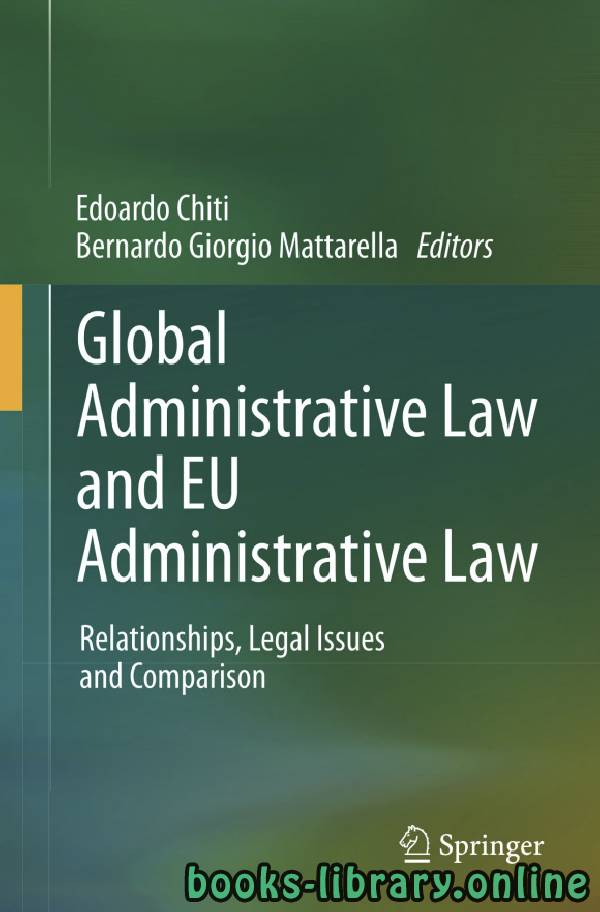📘 قراءة كتاب Global Administrative Law and EU Administrative Law أونلاين


انون باللغة الانجليزية
كلية القانون بالانجليزي
تعريف القانون العام بالانجليزي
كتابة كلمة قانون بالانجليزي
تخصص قانون بالانجليزي
محامي بالانجليزي
ترجمه القانون بالانجليزي
قانوني بالانجليزي
القانون الانجليزي pdf
مادة مصطلحات قانونية باللغة الانجليزية
تحميل كتاب مصطلحات قانونية باللغة الانجليزية pdf
تحميل قاموس قانوني عربي انجليزي pdf
معجم القانون pdf
مصطلحات القانون الجنائي باللغة الانجليزية
جميع الكلمات القانونية باللغة الانجليزية
تعريف القانون باللغة الانجليزية
administrative law through the analysis of their multiple legal relationships. Its
authors are not interested in applying to a number of sectors a predefined set
of EU and global administrative law categories. Rather, they seek to enrich and
refine EU and global administrative analytical tools through the exam of the
manifold relations between the two bodies of administrative law beyond
the State. In this sense, the effort carried out in this book is essentially analytical:
the aim is to begin to explore the complex reality of the interactions between EU
administrative law and global administrative law, to provide a preliminary map of
such legal and institutional reality, and to review it.
The book is the outcome of a two-year research, funded by the Italian Ministry of
Education, by the Istituto di ricerche sulla pubblica amministrazione – Irpa, and by
the Universities of Siena, Rome “Tor Vergata”, Naples, Viterbo, and Campobasso.
The five working groups, each operating in one university, have been coordinated,
respectively, by Professors Bernardo Giorgio Mattarella, Claudio Franchini,
Giacinto della Cananea, Stefano Battini, and Hilde Caroli Casavola. Gianluca
Sgueo has greatly helped to finalize the interactions among the various groups, as
well as to manage the final stages of the project.
The researchers, selected with an international call for papers, have been asked
to examine specific issues, while considering the general framework of global and
European administrative legal principles and some cross-cutting issues, such as the
competences of European institutions and global organizations and their possible
overlap, the public–private dualism at the two levels, the issues of democracy and
representation, the instruments of protection of private subjects towards public
authorities.
The contributions to this book have been organized in six parts. The first part
explores the potentialities of a comparison between EU administrative law and
global administrative law. The second and the third part look at the linkages and
interconnections between global administrative law and EU law. The last three
parts then focus on specific sectors, by analyzing, respectively, cases of parallel
regimes, converging harmonizations, and cross implementations.
The first part of the book discusses the relationships between EU and global
administrative law by comparing some of their features. It does not provide an
analysis of principles, rules and practices of EU and global administrative law.
Rather, it focuses on certain structural elements of their legal systems, taken by
themselves and in their interaction with national law. Somehow unsurprisingly, it
highlights a combination of limited similarities and marked differences.
The comparative inquiry opens with Edoardo Chiti’s analysis of the EU and
global administrative organizations. Three main aspects of such organizations are
compared: the position of the EU and global administrative bodies in the institutional system; the organizational models prevalent in the EU and global
administrations; and the recourse to private actors by the EU and global administrative law for performing specific activities. The analysis reveals a complex and
peculiar pattern of similarities and differences in the administrative organizations
of the EU and the global legal space. EU and global administrations are different in
terms of the “constitutional” anchorage of their public administrations, which is
1 Introduction 3
present in one case but not in the other. They tend to converge as far as their
organizational models and the role assigned to private actors in the exercise of
administrative functions are concerned. But this convergence takes place at a
general level only, while the specific arrangements maintain important,
distinguishing specificities. Such pattern of limited similarities and marked
differences has several explanations: similarities reflect the common functional
needs to which EU and global administrative systems are called to respond, while
differences stem from the particular historical formation of the various systems
beyond the State as well as from the particular place occupied by the European
Commission in the EU legal order.
Barbara Marchetti’s contribution compares the EU judicial system with the
judicial mechanisms of four global regimes: the World Trade Organization, the
UN Convention on the Law of the Sea, the Mercosur and the World Bank. It opens
with a discussion of the multiple jurisdictions – international, constitutional and
administrative – of EU courts. Then, the fundamental structure and functions of the
dispute settlement system of the World Trade Organization, the International
Tribunal for the Law of the Sea, the Mercosur system and the Inspection Panel of
the World Bank are examined. In a global legal space characterized by both
juridification and judicialization, several differences can be identified between
judicial systems founded on voluntary jurisdiction, such as the UN Convention on
the Law of the Sea and judicial systems based on exclusive and obligatory jurisdiction, such as the EU and the WTO. Furthermore, important divergences can also be
found in comparing prima facie similar mechanisms for international compliance.
Bernardo Giorgio Mattarella’s chapter deals with the influence of EU and global
administrative law on national administrative decisions. Proceeding from the theory
of administrative acts, typical of the legal scholarship of many European countries,
the author examines first the way in which the law beyond the state affects the
several steps of administrative decisions: the legal basis for administrative acts,
their making, their contents, their legal effects, their execution and their review.
This analysis displays more similarities than differences between EU and global
law. The different techniques of influence are then investigated, distinguishing
between the secure devices, which ensure the supremacy of European law over
domestic one and the more diverse techniques used by global law. From this point
of view, the differences are bigger, although an accurate exam reveals patterns of
resemblance and convergence. Finally, the outcome of the described phenomena on
crucial legal issues is considered, showing that the theory of administrative act
seems able to adjust to the influence of the law beyond the state, and that even the
impact of the latter on the rule of law and democracy is quite less stressful than one
could expect.
The second and the third part of this book turn to the linkages and interconnections between global administrative law and EU law. Their purpose is to
complement the comparative inquiry carried out in the first part by giving an
impression of the multiple forms in which global administrative law and EU law
come to contact and interact and by exploring the legal challenges inherent to such
variety of interconnections.
القانون الإداري من خلال تحليل علاقاتهم القانونية المتعددة. انها
لا يهتم المؤلفون بالتطبيق على عدد من القطاعات على مجموعة محددة مسبقًا
فئات الاتحاد الأوروبي والقانون الإداري العالمي. بدلا من ذلك ، فإنها تسعى لإثراء و
صقل الاتحاد الأوروبي وأدوات التحليل الإداري العالمي من خلال امتحان
علاقات متعددة بين كيانين القانون الإداري وراءها
الولاية. بهذا المعنى ، فإن الجهد المبذول في هذا الكتاب تحليلي بشكل أساسي:
الهدف هو البدء في استكشاف الواقع المعقد للتفاعلات بين الاتحاد الأوروبي
القانون الإداري والقانون الإداري العالمي ، لتوفير خريطة أولية لل
هذا الواقع القانوني والمؤسسي ، ومراجعته.
الكتاب هو نتاج بحث استمر عامين ، بتمويل من وزارة الإيطالية
التعليم ، من قبل معهد الدراسات العليا سلا بابليكا أمبارزازيوني - إيربا ، وبواسطة
جامعات سيينا ، روما "Tor Vergata" ، نابولي ، Viterbo ، و Campobasso.
تم تنسيق مجموعات العمل الخمسة ، كل واحدة تعمل في جامعة واحدة ،
على التوالي ، من قبل الأستاذين برناردو جيورجيو ماتاريلا ، كلاوديو فرانشيني ،
جياسينتو ديلا كانانيا وستيفانو باتيني وهيلدا كارولي كاسافولا. جيانلوكا
ساعد Sgueo إلى حد كبير في وضع اللمسات الأخيرة على التفاعلات بين المجموعات المختلفة ، كما
وكذلك لإدارة المراحل النهائية للمشروع.
وقد تم سؤال الباحثين الذين تم اختيارهم بدعوة دولية للأوراق
لدراسة قضايا محددة ، في حين النظر في الإطار العام العالمي و
المبادئ القانونية الإدارية الأوروبية وبعض القضايا الشاملة ، مثل
اختصاصات المؤسسات الأوروبية والمنظمات العالمية وإمكاناتها
تتداخل ، الازدواجية بين القطاعين العام والخاص على المستويين ، وقضايا الديمقراطية و
التمثيل ، وأدوات حماية الموضوعات الخاصة تجاه الجمهور
السلطات.
تم تنظيم المساهمات في هذا الكتاب في ستة أجزاء. الجزء الاول
يستكشف إمكانيات المقارنة بين القانون الإداري للاتحاد الأوروبي و
القانون الإداري العالمي. الجزء الثاني والثالث ننظر إلى الروابط و
الترابط بين القانون الإداري العالمي وقانون الاتحاد الأوروبي. الثلاثة الأخيرة
أجزاء ثم التركيز على قطاعات محددة ، من خلال تحليل ، على التوالي ، حالات الموازية
الأنظمة ، وتوحيد التنسيقات ، والتطبيقات المتقاطعة.
يناقش الجزء الأول من الكتاب العلاقات بين الاتحاد الأوروبي والعالمي
القانون الإداري من خلال مقارنة بعض ميزاتها. أنها لا توفر
تحليل مبادئ وقواعد وممارسات الاتحاد الأوروبي والقانون الإداري العالمي.
بدلا من ذلك ، فإنه يركز على عناصر هيكلية معينة من أنظمتها القانونية ، التي اتخذتها
أنفسهم وفي تفاعلهم مع القانون الوطني. بطريقة ما لا يثير الدهشة ، ذلك
يسلط الضوء على مزيج من أوجه التشابه المحدودة والفروق الملحوظة.
يبدأ التحقيق المقارن بتحليل Edoardo Chiti للاتحاد الأوروبي و
المنظمات الإدارية العالمية. ثلاثة جوانب رئيسية لهذه المنظمات هي
مقارنة: موقف الاتحاد الأوروبي والهيئات الإدارية العالمية في النظام المؤسسي ؛ النماذج التنظيمية السائدة في الاتحاد الأوروبي والعالمي
الإدارات. واللجوء إلى الجهات الفاعلة الخاصة من قبل الاتحاد الأوروبي والقانون الإداري العالمي لأداء أنشطة محددة. تحليل يكشف عن معقدة و
نمط غريب من أوجه التشابه والاختلاف في المنظمات الإدارية
الاتحاد الأوروبي والفضاء القانوني العالمي. الاتحاد الأوروبي والإدارات العالمية مختلفة في
شروط مرسى "الدستورية" لإداراتها العامة ، وهو
1 مقدمة 3
موجودة في حالة واحدة ولكن ليس في الحالة الأخرى. انهم يميلون إلى التقارب بقدر ما
النماذج التنظيمية والدور المنوط به للجهات الفاعلة الخاصة في ممارسة
الوظائف الإدارية المعنية. ولكن هذا التقارب يحدث في
المستوى العام فقط ، في حين أن الترتيبات المحددة تحافظ على أهمية ،
التمييز بين الخصائص. هذا النمط من أوجه التشابه محدودة ومميزة
الاختلافات لها عدة تفسيرات: التشابه يعكس الوظيفية المشتركة
يحتاج إلى الاتحاد الأوروبي والنظم الإدارية العالمية للاستجابة ، في حين
تنبع الاختلافات من التكوين التاريخي الخاص للأنظمة المختلفة
خارج الدولة وكذلك من المكان المحدد الذي يحتله الأوروبيون
المفوضية في النظام القانوني للاتحاد الأوروبي.
تقارن مساهمة باربرا مارشيتي النظام القضائي في الاتحاد الأوروبي مع
الآليات القضائية لأربعة أنظمة عالمية: منظمة التجارة العالمية
اتفاقية الأمم المتحدة لقانون البحار والميركوسور والبنك الدولي. يفتح
مع مناقشة الاختصاصات المتعددة - الدولية والدستورية و
إداري - محاكم الاتحاد الأوروبي. ثم ، الهيكل الأساسي ووظائف
نظام تسوية المنازعات لمنظمة التجارة العالمية ، الدولية
محكمة قانون البحار ، ونظام ميركوسور وفريق التفتيش في
يتم فحص البنك الدولي. في فضاء قانوني عالمي يتميز بهما
الاختصاص القضائي وإضفاء الطابع القضائي ، يمكن تحديد العديد من الاختلافات بين
النظم القضائية التي تأسست على هيئة المحلفين الطوعية
سنة النشر : 2011م / 1432هـ .
نوع الكتاب : pdf.
عداد القراءة:
اذا اعجبك الكتاب فضلاً اضغط على أعجبني و يمكنك تحميله من هنا:

شكرًا لمساهمتكم
شكراً لمساهمتكم معنا في الإرتقاء بمستوى المكتبة ، يمكنكم االتبليغ عن اخطاء او سوء اختيار للكتب وتصنيفها ومحتواها ، أو كتاب يُمنع نشره ، او محمي بحقوق طبع ونشر ، فضلاً قم بالتبليغ عن الكتاب المُخالف:
 قبل تحميل الكتاب ..
قبل تحميل الكتاب ..
يجب ان يتوفر لديكم برنامج تشغيل وقراءة ملفات pdf
يمكن تحميلة من هنا 'http://get.adobe.com/reader/'


 منصّة المكتبة
منصّة المكتبة 